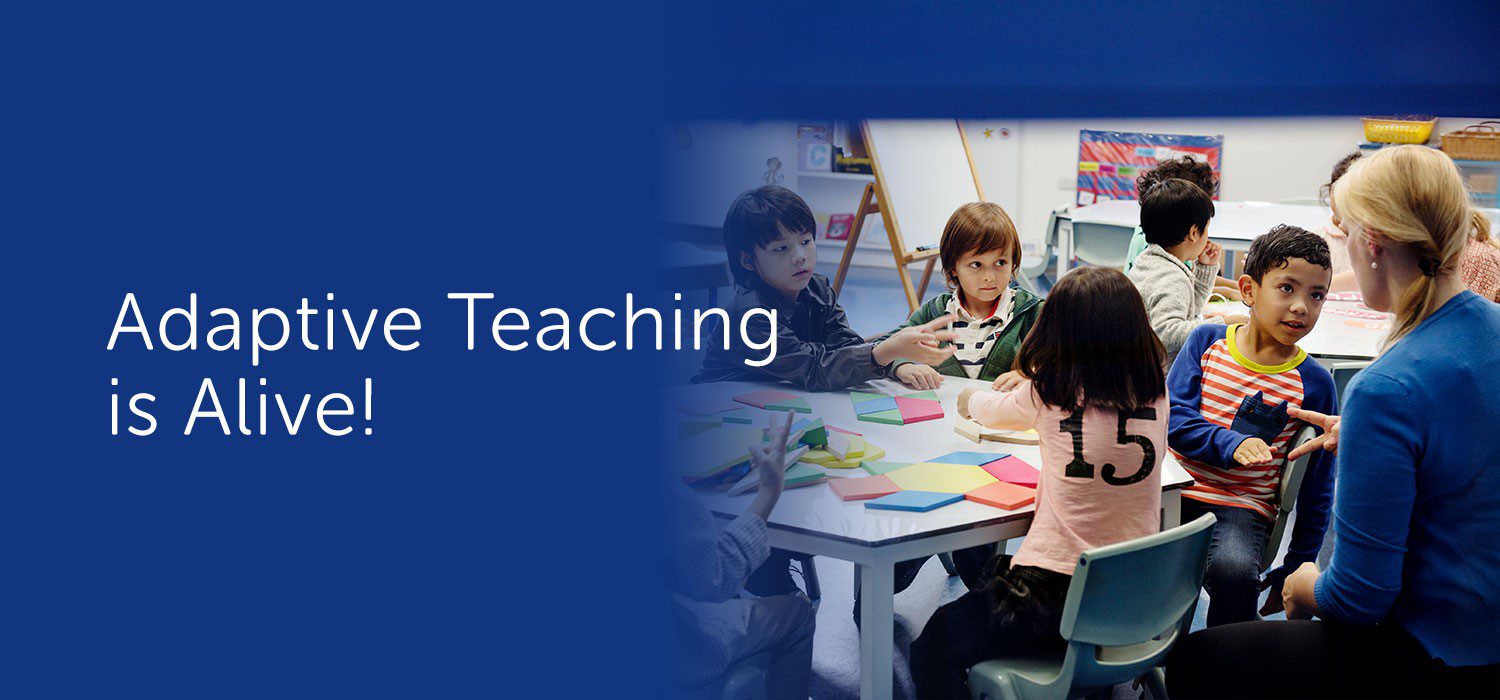Adaptive Teaching is Alive!
In the CLT post, we suggested that exploring adaptive teaching can lead schools to advancements in their curriculum design, quality of teaching, and, crucially, the joining of the two. Here, we present 2 basic features of curriculum design that spring out of adaptive teaching, 3 broad modes for approaching adapting teaching, and finally 3 classic implementation errors.
Curriculum Design: 2 Basic Features
There are two basic requirements of a curriculum designed for adaptive teaching (i.e. one that empowers the teacher to be constantly responding to learners in a purposeful way).
i) A detailed Learning Journey
Adaptive teaching only makes sense when the teacher can see the detail of the curriculum content. The teacher’s first responsive action is to know where each learner is on this detailed learning journey. In order for this to happen, the learning journey needs to be broken down into small parts. The tricky bit is in deconstructing the curriculum into small enough parts to make placing the learner on the journey meaningful, but not so small that it becomes unmanageable and increases workload. Indeed, these parts are the driving momentum that give progressive power to the curriculum’s intent and are the framework to track learners against. If each learner is placed on to this tracking system on entry to school, then the teacher can effortlessly monitor the information detailing where each learner is on the journey.
This curriculum deconstruction should happen just once; at the design stage, and from start to finish. Further to this, an even more detailed curriculum breakdown should also be in place at the design stage, and should also be digitally available to teachers, so that they can guide learners – responding as they go – through the minutia of content. Note that national curriculum statements are often deliberately far broader, and lacking in detail, to be used for either of these purposes. This is a positive! It allows schools to reclaim a distinctiveness to their own curriculum intent and identity.
ii) A minimum, yet high-expectation timeline
Adaptive teaching happens as a response to knowing where learners are in their detailed learning journey, but this response is far more powerful and purposeful if it is a response to where that learner is expected to be in their journey. In other words, a timeline needs to cut right through this journey. A timeline that says, ‘we expect learners to be here at this point in time, and then here by this point in time’ etc. Any national curriculum statements that provide an age-related expectation will be too far apart (e.g. year group statements), so these need to be broken down at the curriculum design stage. Termly checkpoints allow teachers to plan their weeks/days in a responsive manner. Remembering that the minutia of the curriculum content breakdown is at their fingertips, the teacher can translate the agreed termly expectations into their own planning. They can set their own expectations across a week, a lesson, even moment to moment; ‘I expect learners to be here at this point in time, and then here by this point in time’; and then adapt teaching from that expectation, responding and guiding as they go. All of this means that the adaptive teacher is teaching with an ‘expected timeline’ in their mind. This has been lacking for so long. It is this expected timeline that they are guiding learners against, and are using to inform their responses, in the actual moments of instruction. For more on how this ‘guide and respond’ feature of great teaching sits with other features, see ‘The 5 Megatruths of Great Teaching’.
Adaptive Teaching: 3 Modes of Adaption
Once we can recognise the position of our learners, not just on the detailed learning journey, but also in relation to where we expect them to be, then our teaching can be adapted through three broad modes:
i) Adapting teaching for those learners behind the expected journey:
There are no long-term ‘low ability’ groups. There are also no children journeying through the curriculum ‘off track’ for no good reason. Learners would only be behind the age-related expected timeline that cuts through the detailed curriculum journey if:
- They have a relevant learning difficulty (these learners are not ‘off track’ but are at their own expected place on the journey), and there is evidence that school inspectors would agree with that justifies this, or,
- They have not enjoyed the benefit of this curriculum design from the beginning of their education (e.g. they may suddenly have arrived from another school, or the school may have just started to implement this curriculum).
In these cases, teaching still needs to build on learners’ personal background knowledge, and the teacher will know this prior to adapting their planning out of consideration for those specific individuals and the specific upcoming curriculum content. Adaptive teaching is always bespoke. What is crucial in this scenario, is that the teacher knows each learner, where they are on their journey, what the expectations are for the next week/term/year, and most importantly they can explain why!
ii) Adapting teaching for those learners on the expected journey:
Within this detailed curriculum journey (designed to support and empower the responsive teacher), a large group of learners within a class/cohort will come to be ‘cognitively ready’ for new input together. Once direct instruction is complete, learners will move along an outward journey to deeper learning, rather than racing ahead along the curriculum timeline. The teacher focuses, guides, and responds to learners throughout and this is now accentuated as the teacher guides learners with a more personalised response along this outward journey. Typically, more able learners within this large group will move outward more rapidly, spending more time in the deeper learning challenges of, for example;
- problem-solving,
- connecting the knowledge to a bigger curriculum picture, and
- transference into cross-curricular and real-life contexts.
Crucially, the large group will be brought together at the end of this learning sequence (regardless of how far along the outward journey they travelled). This means they are ready for a common direct input on the next progressive step of core knowledge (fitting with the ‘on track’ timeline), thus maintaining a managed spread and managed teacher workload at all times. This reduces the need to adapt in the future and is part of the constant process of managing the vertical spread of ability.
iii) Adapting teaching for those learners ahead of the expected journey:
This mode of adaptive teaching is almost identical to those behind the expected journey. The key feature here is that even the extension into more challenging material described above provides insufficient cognitive load for these particular individuals in this particular aspect of learning. Again, there are no long-term ‘high ability’ groups, this bespoke adaption only arises out of considering the precise individuals and the precise curriculum content of the moment. If the adaptive teaching for the bulk of the class mentioned above is successful in enriching learning, then there will be fewer learners considered to be ‘ahead of track’ than historically might have been the case.
Implementation: 3 Classic Errors
The principles of adaptive teaching will not immediately be effective if classes currently have a wide spread of varying abilities. This is further confounded when many learners are actually below where they are expected to be. We could call this an ‘unmanaged spread’, and it is a crippling classroom context for any teacher instructing on a sequential curriculum learning journey (crippling in terms of workload and effectiveness). This should be seen as a reason for implementing this adaptive teaching curriculum, as opposed to a reason for dismissing it. It is a ‘pre-implementation state’ and an ‘early-implementation state’.
There are three common implementation errors that spring from this scenario:
- A false mindset of ‘this won’t work and we need to return to the fixed ability groupings of differentiation’.
- To immediately start providing input to one large group within the class and then adapting teaching in the remainder of the lesson, as if the larger group were all ready for a common input when actually they are not (this can be a misconception arising from some, so-called, ‘mastery’ approaches).
- To start off down this road but then not follow through on this elimination of an unmanaged spread, typically gradually returning to differentiation.
Both of the first two errors can be avoided through more specific adaptive teaching techniques being employed initially and over a fixed time period. These will work to eliminate the unmanaged spread and bring it into line as a ‘managed spread’, ready for a higher level of adaptive teaching. It is worth noting that the unmanaged spread doesn’t need to be there. As each new cohort starts school on the curriculum journey, then the ‘bringing together of one large group’ can start immediately. Of course, it won’t always be neat and perfect, but it does mean that an ability spread can never be allowed again to just disperse itself, unnoticed and unaddressed. Prevention is better than intervention.
Conclusion: A Pleasant Surprise!
The implications of adaptive teaching as an alternative approach to differentiation are that the school needs to own a curriculum design that supports the teacher who adapts their teaching as a response to where learners are in relation to where they are expected to be. This responsiveness is happening at all times and at all levels; in the moments of teaching, the adjustments of short-term plans, in end-of-term data meetings, etc. The school is constantly responding to the same issue; ‘Are learners where we expect them to be in our deconstructed curriculum journey?’. In other words, we have the life and the detail behind the ultimate school question, ‘Is the implementation of our curriculum design having the intended impact?’.
Perhaps a surprising consequence of a curriculum designed to support adaptive teaching, is that the more it gathers momentum across the school, the less need there is to adapt. And with that, comes a natural reduction in workload and a rising of standards. The double whammy setback of differentiation (low impact, high workload) becomes the win-win scenario of adaptive teaching (high standards, reduced workload)!

